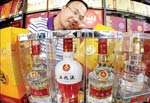Forestry sector speeds up development
Updated: 2011-10-06 08:19
(Xinhua)
|
|||||||||
BEIJING -- China's forestry resources are being utilized more rationally and effectively than ever, while the industry is growing faster yearly, yet the country still aims to implement further adjustments, according to the head of the state forestry administration.
The latest statistics from China's State Forestry Administration (SFA), indicate the total output value of the forestry industry reached 1.66 trillion yuan ($255 billion) in the first eight months of the year, up 9 percent from the same period last year.
"Recent years have witnessed significant growth in the industry. Last year, the output value of forestry surpassed 2 trillion yuan, which was quite a breakthrough for us," said Jia Zhibang, head of the SFA.
In China, forests are defined as woods covering an area of more than 1 mu (667 square meters) with a crown density -- the amount of sunlight blocked by plant material -- at or above 20 percent, according to the SFA.
Coming together with the rising output value in the sector is the improvement in its structure. According to the SFA, the ratio of the primary industry, secondary industry and tertiary industry in the sector was adjusted to 39 to 52 to 9 from 52 to 41 to 7 in 2005. The weight of the latter two industries kept growing over time.
The SFA said growth in secondary industry was mainly boosted by wood and bamboo products while forest tourism helped to shore up the tertiary industry.
Meanwhile, the booming industry has prompted a lot of industrial clusters around the country.
Anji County, located in east Zhejiang province, claims only 2 percent of the country's bamboo resources, but its annual production value reaches 12 billion yuan and it takes up 20 percent of country's market share of bamboo products.
The rapid pace of industrialization in the sector has already made China a leading country for producing forestry products.
According to the SFA, China produced the most rosin, fabricated boards, bamboo and rattan wood furniture, and timber floor products of any country in 2010. Its production of fresh and dried fruits and flowers also ranked atop in the world.
According to official figures, China's value of imports and exports of forestry products jumped to over $90 billion in 2010 from the $40 billion in 1996.
In the first seven months of this year, the total value of imports and exports of forestry products rose 29.1 percent from the same period last year to reach $67.96.
Despite the growth in the sector, the government is well aware of the problems and challenges in the industry.
In the country's development plan for the forestry industry during the 2010-2012 period, the SFA noted that the growth pattern in China's forestry sector was mainly extensive. In 2008, science and technology factors only attributed to 39.1 percent of the sector's growth.
Worse still, Chinese producers care little about branding. Despite the impressive figures of exports, few Chinese brands were widely acknowledged globally.
The plan by the SFA said China will move to further optimize industry structure, nurture leading enterprises, and create world-recognized brands to increase the sector's competitiveness.
"Our next step is to foster more strategic emerging industries to promote the quality in the sector," Jia said.










